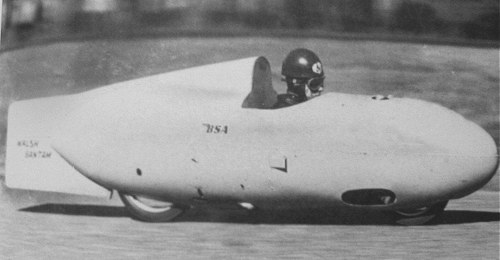Walsh 125cc Bantam LSR bike
EDIT: This is a photo of a Land Speed Streamliner, not a road racer - it did 115 mph in 1957 before ignition issues limited the RPM.
The Walsh Bantam road racer was thought to be the fastest 125 in the world in the early 1950s. Bill Lomas rode one in a 250 RR practice session on a trip in the off season to Australia. He started from the back of the grid and by the end of the 7-8 lap practice had caught the front-runner 250s. NOTE: This paragraph refers to a conventional HF racer, not the picture, and is meant to give background on the Walsh Bantam engine potential.



Interesting shape
Quite a good shape for the period, high nose, nice and blunt, flow over the upper surface probably separating at the rear edge of the curved aection - and a decent amount of tail area. It looks rear-engined too, very modern. Bit maschotistic to use a Bantam power plant though... Do you think he's gripping the front cockpit edge with his teeth?
You have to be impressed by the sheer number of perfectly good examples of FF's that keep coming out of the historical woodwork - all being doggedly ignored by the motorised bicycle crew!
Fast old FF racers vs Modern HF arguments on FB
I have just posted a link to this machine and its description to Eric Offenstadt's Facebook page: 'Motorcycle Suspensions and Kinetics' because Eric posted a photo of a Peraves Monotracer on the page a few days ago and a pro vs anti FF argument has been raging there ever since. I've naturally posted links to Royce's descriptions and explanations of the advantages of the FF layout and certain people have had the temerity to claim that he is wrong and that modern racers go quicker than their predecessors because their designers have been busy raising the CofG for the past 30 years......and that a high CofG actually enables a rider to switch direction quicker than a low one!
Obviously the sooner the Monoliner gets out on a track with a half-decent, open-minded fearless young racer on board, the better! PNB
Please note correction to original text
It seemed perfectly clear when I wrote the original text, but I now see how the comments did not clearly distinguish between the HF RR bike and the FF LSR version. I hope that doesn't leave too many people dangling after posting somewhere about the cool and fast Bantam FF road racer that blew everyone away back in the day.
Sorry for any confusion that I might have caused. I thought it would be clear that an LSR bike would not be engaging in a RR practice.
LSR vs HF versions of the Walsh Bantam
Shame! I'm disappointed by this news Michael. To say "I thought it would be clear that an LSR bike would not be engaging in a RR practice." is one hell of an assumption back in the days before the 1957 aero ban, not least because I know for a fact that there was at least one FF racer built and raced at that time. I actually thought that this picture might be the self-same machine with some extra bodywork.
Somewhere I have a photo of the FF racer in question which will better explain my confusion.
Also, with my pedant's hat on, I would never use abbreviations like LSR and RR before first spelling them out in full as Land Speed Record & Road Race! PNB
Fast old arguments versus modern ones etc.
On inspection 'certain people' might discover that modern race bike designers have been raising the CG of the machinery that makes up the racing motorcyle in order to reduce the polar moments of inertia of the total vehicle, which, however loosely, includes the rider - who has remained in the same position since 1956 (at least). This, as noted in the Bikeweb articles, is entirely different from reducing the total CG hieght of the vehicle by lowering the rider into it - co-incidentally reducing the polar moments at the same time.
If any motorcycle racers had the balls and imagination to actually race an FF, in E-bike racing, as allowed by the regs. these last few years - even if only to gain the huge aerodynamic advantage of the reduced frontal area*- they would be able to discover all the other advantages for themselves, including winning races until everyone else woke up.
Meanwhile, study of Newtons Three Laws, Gallileo's different sized balls etc. may reduce their confusion.
*
Kawasaki Ninja, reider in full race crouch - Cd .5
Monoliner, rider normally seated - Cd .21
Data - MIRA wind tunnel.